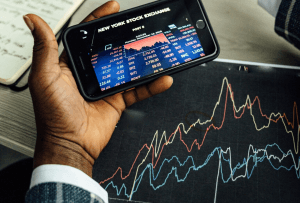The S&P 500 Slipped, Alibaba Tumbled — And What Else Happened In The Stock Market Today
Mar 14, 2022

Stocks pared previous advances on Monday as investors awaited the results of ongoing talks between Russia and Ukraine ahead of the Fed's decision on Wednesday. Tech stocks suffered a significant fall.
The Dow Jones Industrial Average ended a point higher, but the S&P 500 fell 0.7%. The Nasdaq Composite Index lost 2%. Previously in the day, all three main indices were in the positive territory.
"The day began with some hope for progress in the peace discussions," stated Michael Reinking, chief market analyst at the New York Stock Exchange. "Unfortunately, the actual situation on the field does not reflect that."
According to the media, Leonid Slutsky, a member of the Russian group negotiating with Ukraine, said that "substantial progress" has been made in the two sides' peace talks.
This contributed to the decline in the price of oil. WTI crude oil declined 7% to around $101 per barrel. It has now fallen from a multiyear high of $130 reached a week ago. Markets worry that if the confrontation between Russia and Ukraine continues, Western countries may embargo Russian oil—the US has already put limitations on Russian oil imports—dramatically reducing world supplies. This will simply exacerbate the severe inflation already felt by consumers.
While the decrease in oil prices initially aided stock gains, the market remains vulnerable to sell-offs such as the one saw Monday afternoon, as macroeconomic instability continues to stay elevated. Despite some chatter about a resolution between Russia and Ukraine, there's no firm proof as Russian attacks in Ukraine continue.
Companies lost their advances across the board "as confidence about diplomatic attempts to resolve the Ukraine crisis wanes," according to Edward Moya, a senior market analyst at Oanda.
Additionally, the Federal Reserve will publish its rate decision this week. Investors anticipate the Fed to raise the benchmark lending rate by a quarter of a percentage point, but will closely monitor if the central bank indicates a more hawkish rate hike path in the future. A more proactive Federal Reserve might result in even weaker economic development.
In general, "with a perfect storm of market drivers—inflation at record levels, severe geopolitical conflicts, and an upcoming Fed decision—there are few indications of volatility abating," noted Chris Larkin, managing director of trading at ETrade.
Regarding the Federal Reserve particularly, "the anticipated rate hike on Wednesday comes at a difficult and dangerous time, as we are presently confronted with a slowing economy and uncontrolled food and fuel inflation," stated Danielle DiMartino Booth, CEO and chief strategist of Quill Intelligence and a former adviser to the Dallas Fed president.
Treasury rates increased across the board on Monday, with the 5-, 7-, and 10-year notes losing the most ground, as concerns about Wednesday's Federal Reserve meeting overcame concerns about the Ukraine situation. The 10-year yield on the benchmark note increased 14 basis points, or hundredths of a percentage point, to 2.13%. Stock markets are now pricing in a 25-basis-point rate rise this week and a 50-basis-point boost in either May or June.
The tech-heavy Nasdaq lagged the other indices for a valid reason. Since March 1, the yield on the 10-year Treasury note has increased to 2.1% from 1.72%, due to the note's price decline. As markets grow somewhat more confident about the conclusion of the Russia-Ukraine conflict — and as the Fed is nearly expected to hike interest rates on Wednesday — investors have shifted their capital away from safe government bonds.
The 10-year yield is now hovering at its pandemic-era peak, and a break above that level might imply a sustained increase in the yield. This is negative for technology equities since higher long-term bond rates diminish the value of future earnings, and many technology businesses are valued based on significant earnings many years in the future.
Internationally, the picture was mixed, with the pan-European Stoxx 600 index rising 1.2% while Hong Kong's Hang Seng Index fell 5%.




